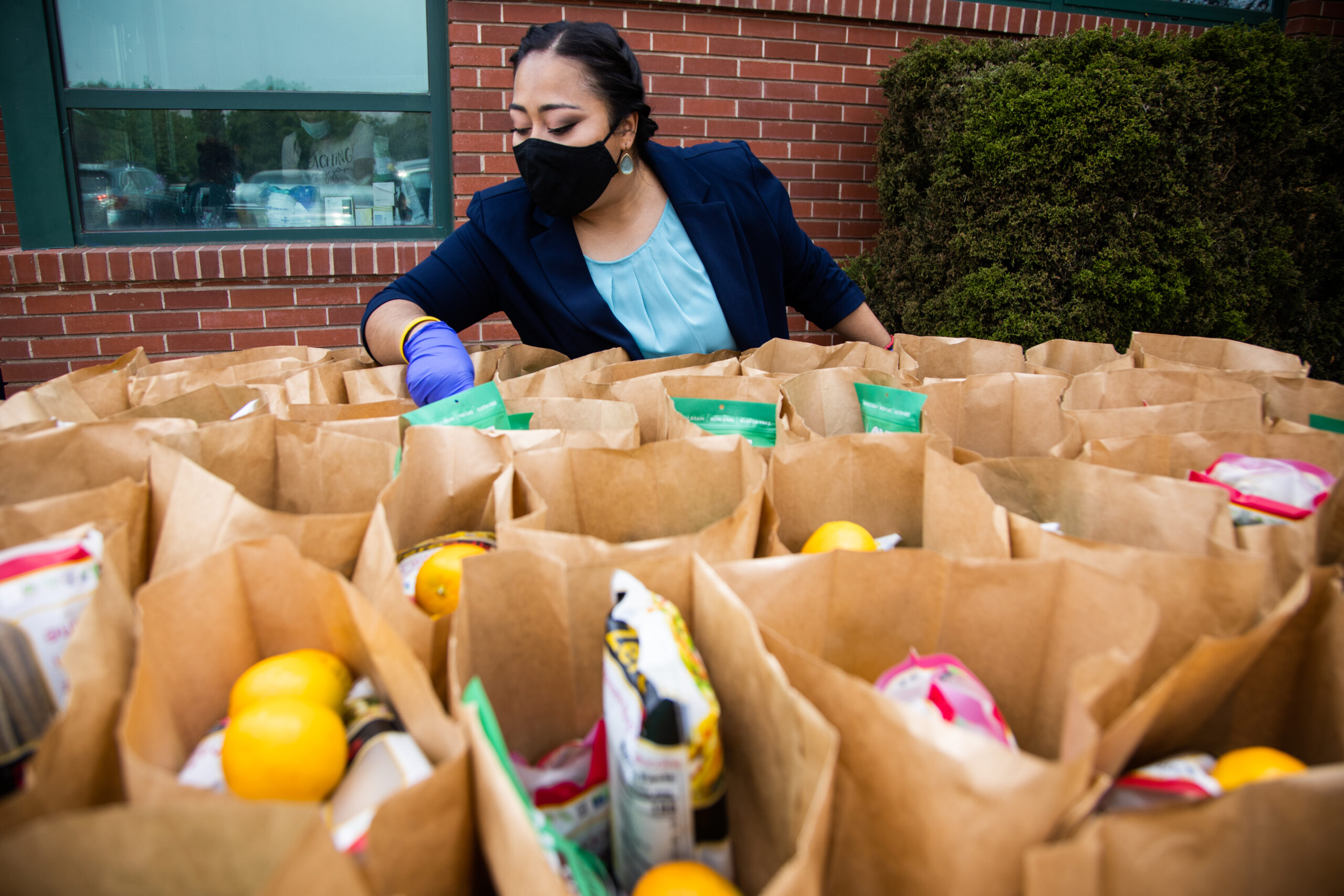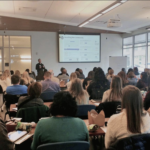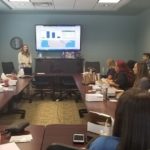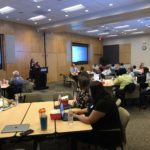Cutting through the Noise: Sustainable Social Care
As the need for social care navigation rises within the U.S., an increasing number of vendors are treating this as an opportunity to make money instead of creating meaningful change. (You may even be familiar with the phrase “Social Determinants of Health (SDoH) Gold Rush,” which some have used to describe this trend.)
At Aunt Bertha, we’re solving for social determinants using sustainable models that serve all in the long term. To help organizations cut through the noise, we’ve put together a few questions organizations should ask when evaluating vendors, with our own take on responses.
Is your network a closed loop system?
Absolutely! Three entities can close the loop on a referral: the person (or family member) in need, the organization that makes the referral, and the CBO that receives the referral. Once the loop is closed by one party, all three parties can see this information. CBOs can also document referral outcomes, schedules, screenings, and other items pertaining to a referral—all of which are available to view in the Aunt Bertha Platform.
![]() Organizations can monitor referral outcomes from the seeker profile.
Organizations can monitor referral outcomes from the seeker profile.
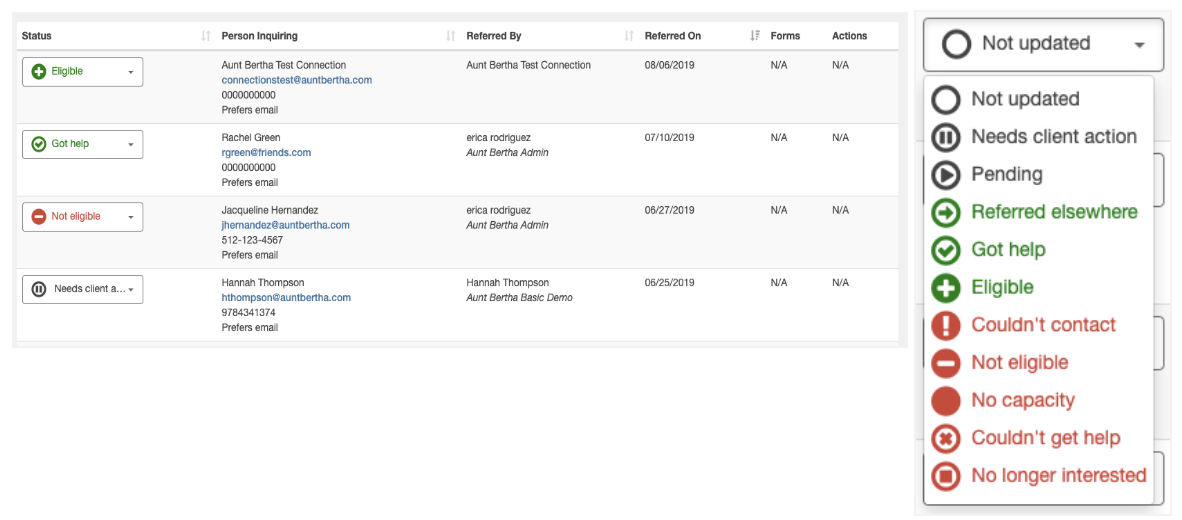 In the Aunt Bertha Platform, organizations can update referral statuses via email or the dashboard, where teams can monitor incoming updates.
In the Aunt Bertha Platform, organizations can update referral statuses via email or the dashboard, where teams can monitor incoming updates.
In the video below, we describe the three different types of networks we support: coordinated, participating and open networks. Although we happily support our customers who prefer Service Level Agreements (SLAs) and other arrangements for close partnerships, we also support networks with greater flexibility for nonprofits who want to participate and use the platform for their intake mechanism. These nonprofits do not need contracts to participate in the closed loop network. This approach supports scaling participation in the network.
We support coordinated networks with strong referral relationships, participating nonprofits who will respond to referrals and members who prefer other mechanisms of intake. Watch this short video to see the difference between these networks.
Should a vendor guarantee a specific service or outcome?
We believe nonprofits should join networks because they see mutual value, not simply because an insurance company or a state government is tying funding to the activity. Vendors that guarantee services from nonprofits have to use contracts, closed networks, and a limited scope of programs to meet those expectations, which are often short-lived. The result of this promise is a very small network.
Our experience shows that nonprofits are responsive with replies and services for the long term when there is trust in the community. That’s why we work in partnership with our customers to build this trust and it’s an investment we make together over time. Vendors can play an important role in bringing organizations together to create trust, share tools, and align incentives. However, we don’t believe this community trust should be outsourced to a vendor or a vendor contract, as this creates an unsustainable arrangement for communities often focused only on industry goals (ex: should a nonprofit do one thing for a healthcare provider, and then something entirely different for an education provider?).
More and more nonprofits join sustainable networks as incentives align. We encourage our customers to sit at the same table as nonprofits with their sleeves rolled up, working hand in hand with nonprofits. Vendors like ourselves have a place, but it’s as additional collaborators sharing best practices and encouraging this participation.
Do referrals include individuals’ consent and understanding of the referral?
Yes. We take great care to ensure that the Seeker’s consent is captured. Any person or organization making a referral must confirm that they have received the person’s consent before submitting the referral. The level of consent required will vary by user based on their organization’s policies. A referral cannot be sent without confirmation of consent, and the confirmation is stored with the referral record.
We’re a HITRUST certified organization and we follow all security best practices.
Can the referral sender communicate with an individual and their care team after sending a referral?
Yes. After a referral is sent, the organization staff, the receiving CBO, and the helper supporting the seeker will have the ability to view the seeker’s contact information to reach out if needed. If the sender is a part of the community care team, they can share notes to communicate with other team members.
Is there reporting on specific replies, outcomes, and impact of services?
Yes. Aunt Bertha’s analytics tools provide specific reports on responses, status of responses, specific outcomes tracking reports, as well as specific services delivered. Nonprofits can use outcomes tracking when documenting specific outcomes and services. Helpers (staff) conduct goal tracking, notes, and assessment that offer insights into what factors lead to success in helping people in need. Our customers bring outcomes data into their own reporting processes for further ROI study and marriage within clinical and claims data.
What is the community engagement process? Who is the team dedicated to integrating the platform into each organization’s workflow?
We have an in-house and onsite shared services community engagement team working with more than 240 customers across the United States. We know that building and maintaining successful relationships with nonprofits in the local community requires trust.
At Aunt Bertha, our dedicated Community Engagement team focuses on building long term relationships between helpers and nonprofits in the community. We foster deep connections by bringing customers to the table to share, teach, train and invest in community alignment. Our approach is a long-term process through which customers partner alongside with us — not outsource to us. We run network events, lunch and learns, workshops, webinars, and many more events each month across the country. We also teach and train our customer community liaisons to similarly build relationships in the community for the long term. Our team listens and engages nonprofits in our network building to deepen engagement and participation. With this approach, we have successfully proven the ability to grow a sustainable social care network that thrives beyond the onboarding period. In 2019 alone, we ran 42 workshops across 29 cities, and had more than 1,000 organizations in attendance.
Can you help measure impact, time savings, and more with comprehensive reporting?
Yes. We’re proud to say that our platform has provided incredible efficiencies in referral and follow-up processes for all of our customers. Whether they’re moving from manual, paper-based directories or are addressing a heavy volume of utilizers to local providers, the time savings of our systematic workflows are clear and immediate and can be measured.
Through our reporting suites, customers have access to invaluable insight into Seeker, nonprofit, and staff activity, plus outcomes tracking to better inform ROI and supplement clinical and claims data.
 Heat mapping illustrates search and referral activity on our platform at the national, state, county, city and postal code level.
Heat mapping illustrates search and referral activity on our platform at the national, state, county, city and postal code level.
 Reporting and dashboarding tools help identify needs in the community and available resources to inform goals.
Reporting and dashboarding tools help identify needs in the community and available resources to inform goals.
What does your community network look like?
Our social care network is the largest and most widely used to date, and the only social services platform whose network includes programs for every ZIP Code in the United States. We touch every county throughout the U.S. with no preference between large cities, small towns, and rural areas. You can find a minimum of 875 programs in any county, with some counties at over 4,000 programs listed.
By joining this network made up of an installed user base already sending and receiving high volumes of referrals, clients are able to help their communities immediately and skip the lengthy onboarding of other “pay us and we’ll build it” network models.
Our customers can focus the network with their in-network nonprofits (coordinated) where they always expect responses and participation, though they also have access to the long tail of services, thus making it the strongest network for staff and seekers at the same time.
We love sharing the size and scope of our network so much, we’ve made this information readily available to the public via our interactive dashboard, located here:
Aunt Bertha’s Social Care Network: An interactive map demonstrating the strength of our social care network in every county
in the United States.
Do you have strong EHR integrations?
Yes. We have a long history of working directly with providers of EHR systems, including athenahealth, eClinicalWorks, Epic, and Cerner so that the record of care follows a patient from inside clinical walls out into the community. We have both SMART on FHIR integrations that are closed-loop, as well as Native integrations in the EHR entirely.
We’ve included links to some of our more popular integrations below:
- Cerner: https://code.cerner.com/apps/auntbertha
- Epic (Native): https://apporchard.epic.com/Gallery?id=1199
- Epic (Launch): https://apporchard.epic.com/Gallery?id=161
- Innovacer: https://innovaccer.com/solutions/sdoh/
- Altruista: https://www.altruistahealth.com/resources/social-determinants-of-health
In Summary
We welcome prospects to chat with us anytime. If you’d like a demo, or want to speak to someone on our team, just reach out and we’re happy to walk you through any and all of this functionality.
As you move forward with the important work of addressing social care within your organization, we want to make sure you have as much information as possible. There’s a lot of hype in this space, and sometimes it’s hard to know what’s real. During your due diligence process, it’s important to ask the questions we’ve shared above, as well as others such as:
- How many users does the vendor you’re evaluating have in your service area?
- How many participating CBOs does the vendor you’re evaluating have in your service area?
- How many electronic connections has the vendor you’re evaluating facilitated in your service area?
Pay attention to whether the vendors you’re evaluating are willing to answer these questions. Or, do they ask for a non-disclosure agreement (NDA)? If it’s a vendor that spends a lot of time talking about outcomes, are they willing to share those outcomes with clear, complete data that illustrates their claims?
Hopefully, as you’ve interacted with our website over the years and spoken to our team, you’ve found us to be open and transparent about what we can accomplish together. You might also find that we’re far more open about answering the questions above than others in the space.
We’re not slick, and we take pride in being straightforward. We understand that we’re tackling hard problems and it takes true partnership with our clients. We’re an open book, we’re committed to the long run, and we’re here to help. Call us anytime.
Interested in learning more?
Reach out to us here.
